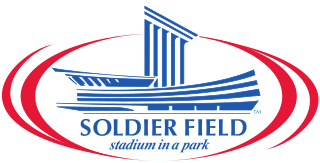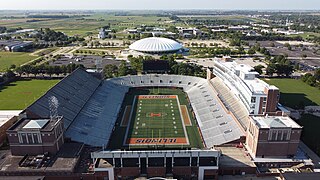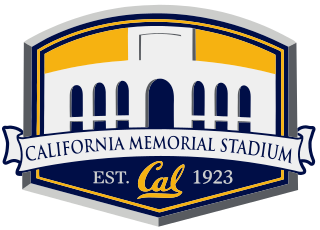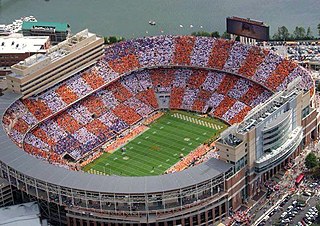
Arrowhead Stadium is an American football stadium in Kansas City, Missouri. It primarily serves as the home venue of the Kansas City Chiefs of the National Football League (NFL). The stadium has been officially named GEHA Field at Arrowhead Stadium since March 2021, following a naming rights deal between GEHA and the Chiefs. The agreement began at the start of the 2021 season and ends in January 2031 with the expiration of the leases for the Chiefs and Royals with the stadium's owner, the Jackson County Sports Complex Authority.

Hard Rock Stadium is a multi-purpose stadium located in Miami Gardens, Florida, United States. The stadium is the home field for the Miami Dolphins of the National Football League (NFL) and the Miami Hurricanes, the University of Miami's NCAA Division I college football team.

The Miami Orange Bowl was an outdoor athletic stadium in Miami, Florida, from 1937 until 2008. The stadium was located in the Little Havana neighborhood west of Downtown Miami. The Miami Orange Bowl was considered a landmark and served as the home stadium for the Miami Hurricanes college football team from 1937 through 2007 and for the Miami Dolphins for the Dolphins' first 21 seasons until Joe Robbie Stadium, now Hard Rock Stadium, opened in nearby Miami Gardens in 1987. The stadium also was the temporary home for the FIU Golden Panthers for one year, in 2007, while its on-campus venue, now known as Riccardo Silva Stadium, underwent expansion

Soldier Field is a multi-purpose stadium on the Near South Side of Chicago, Illinois, United States. Opened in 1924 and reconstructed in 2003, the stadium has served as the home of the Chicago Bears of the National Football League (NFL) since 1971, as well as Chicago Fire FC of Major League Soccer (MLS) from 1998 to 2005 and since 2020. It also regularly hosts stadium concerts and other large crowd events. The stadium has a football capacity of 62,500, making it the smallest stadium in the NFL. Soldier Field is also the oldest stadium established in both the NFL and MLS.

Camping World Stadium is an outdoor stadium in Orlando, Florida, United States located in the West Lakes neighborhood of Downtown Orlando, west of new sports and entertainment facilities including the Kia Center, the Dr. Phillips Center for the Performing Arts, and Inter&Co Stadium. It opened in 1936 as Orlando Stadium and has also been known as the Tangerine Bowl and Florida Citrus Bowl. The City of Orlando owns and operates the stadium.

Husky Stadium is an outdoor football stadium in the northwest United States, located on the campus of the University of Washington in Seattle, Washington. It has been home to the Washington Huskies of the Big Ten Conference since 1920, hosting their football games.

The Cotton Bowl is an outdoor stadium in Dallas, Texas, United States. Opened in 1930 as Fair Park Stadium, it is on the site of the State Fair of Texas, known as Fair Park.

The Los Angeles Memorial Coliseum is a multi-purpose stadium in the Exposition Park neighborhood of Los Angeles, California, United States. Conceived as a hallmark of civic pride, the Coliseum was commissioned in 1921 as a memorial to Los Angeles veterans of World War I. Completed in 1923, it will become the first stadium to have hosted the Summer Olympics three times when it hosts the 2028 Summer Olympics; the stadium previously hosted the Summer Olympics in 1932 and 1984. It was designated a National Historic Landmark on July 27, 1984, a day before the opening ceremony of the 1984 Summer Olympics.

CEFCU ('sef-kyü) Stadium, formerly known as Spartan Stadium, is an outdoor athletic stadium on the west coast of the United States, located in the Spartan Keyes neighborhood of central San Jose, California. Owned by San José State University, the venue is the longtime home of Spartan football; it also hosts the university's commencement ceremony on Memorial Day weekend, and occasional high school football games. Known as Spartan Stadium for over eight decades, it was renamed in 2016.

The Sun Bowl is an outdoor football stadium in the southwestern United States, on the campus of the University of Texas at El Paso. It is home to the UTEP Miners of Conference USA, and the late December college football bowl game, the Sun Bowl. The stadium opened in 1963 and has a nominal seating capacity of 51,500, although UTEP currently lists the capacity as 46,670.

Memorial Stadium is a stadium on the campus of the University of Illinois Urbana-Champaign in Champaign, Illinois, United States. The stadium, used primarily for football, is a memorial to the university's students who died in World War I; their names are engraved on the nearly 200 pillars surrounding the stadium's façade. With a capacity of 60,670, the stadium is primarily used as the home of the university's Fighting Illini football team.

Rice Stadium is an American football stadium located on the Rice University campus in Houston, Texas. It has been the home of the Rice Owls football team since its completion in 1950, and hosted John F. Kennedy's "We choose to go to the Moon" speech in 1962 and Super Bowl VIII in early 1974.

California Memorial Stadium also known simply and commonly as Memorial Stadium is an outdoor college football stadium on the west coast of the United States, located on the campus of the University of California in Berkeley, California. It is the home field for the California Golden Bears of the Atlantic Coast Conference.

Neyland Stadium is a sports stadium in Knoxville, Tennessee, United States. It serves primarily as the home of the Tennessee Volunteers football team, but is also used to host large conventions and has been a site for several National Football League (NFL) exhibition games. The stadium's official capacity is 101,915. Constructed in 1921 as Shields–Watkins Field, the stadium has undergone 16 expansion projects, at one point reaching a capacity of 104,079 before being slightly reduced by alterations in the following decade. Neyland Stadium is the sixth largest stadium in the United States, the eighth largest stadium in the world, and the second largest stadium in the Southeastern Conference. The stadium is named for Robert Neyland, who served three stints as head football coach at the University of Tennessee between 1926 and 1952.

The Rose Bowl is an outdoor athletic stadium located in Pasadena, California. Opened in October 1922, the stadium is recognized as a National Historic Landmark and a California Historic Civil Engineering landmark. At a modern capacity of an all-seated configuration at 92,542, the Rose Bowl is the 16th-largest stadium in the world, the 11th-largest stadium in the United States, and the 10th-largest NCAA stadium. The stadium is 10 miles (16 km) northeast of downtown Los Angeles.

Martin Stadium is an outdoor athletic stadium in the Northwestern United States, on the campus of Washington State University in Pullman, Washington. It is the home field of the Washington State Cougars of the Pac-12 Conference.

Navy–Marine Corps Memorial Stadium is an open-air stadium located off the campus of the United States Naval Academy in Annapolis, Maryland. Opened in 1959, it serves as the home stadium of the Navy Midshipmen college football and lacrosse teams, and was the home of the Chesapeake Bayhawks of Major League Lacrosse. The stadium is also the host of the Military Bowl.
Warren McGuirk Alumni Stadium is a 17,000-seat multi-purpose stadium in Hadley, Massachusetts, on the campus of the University of Massachusetts Amherst.

Bobcat Stadium is an outdoor athletic stadium in the western United States, located on the campus of Montana State University in Bozeman, Montana. It is the home of the Montana State Bobcats college football team of the Big Sky Conference.
Rogers Field was an outdoor athletic stadium in the northwest United States, on the campus of Washington State University in Pullman, Washington. It was the home venue of the WSU Cougars football and track teams until severely damaged by a fire in April 1970. Partially demolished in early 1971, Rogers Field was replaced by the concrete Martin Stadium, which was built on the same site and opened in 1972.



























